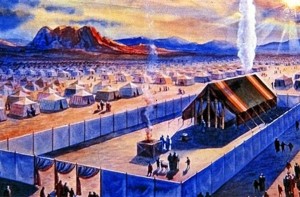Tent or Temple?
 It is often pointed out that the author of the letter to the Hebrews speaks of the Jerusalem temple as if it is still standing.
It is often pointed out that the author of the letter to the Hebrews speaks of the Jerusalem temple as if it is still standing.
Repeatedly. He refers to it as still standing multiple times.
This suggests that the book of Hebrews was written before the Romans destroyed the temple in A.D. 70.
The thing is, the author of Hebrews doesn’t refer to it as the temple. Instead, he refers to it as the “tent.”
This is a reference to the “tent of meeting” or “tabernacle” that the Hebrews built under Moses, before the temple was first constructed by Solomon.
Some have thought that this reference means he wasn’t referring to the temple, which might or might not have been destroyed by the time the letter was written.
They also propose various other arguments to cast doubt on whether the references to the still-functioning temple/tent reveal a pre-A.D. 70 date, but let’s set those aside. Here I want to focus on the one based on the references to the temple as if it were the tent of meeting.
This could simply be a literary way of referring to the temple, based on its pre-history as the tent of meeting.
Is there evidence that this view is correct?
I think there is. In Hebrews 9:6-9, we read:
These preparations having thus been made, the priests go continually into the outer tent, performing their ritual duties; but into the second only the high priest goes, and he but once a year, and not without taking blood which he offers for himself and for the errors of the people.
By this the Holy Spirit indicates that the way into the sanctuary is not yet opened as long as the outer tent is still standing (which is symbolic for the present age).
Got that?
The author regards the “outer tent” as “still standing,” and this “is symbolic for the present age.”
If the successor to the temple, the temple, had already been destroyed then it is very hard to imagine how he could conceive of the “outer tent” as “still standing.”
It would have–rather obviously–have fallen and thus not be symbolic of the present age.
How could he expect his readers in a post-70 environment to see the outward manifestation of the tent as still standing and symbolizing the present age?
It thus seems far more likely that he was simply using the language of the “tent” as a literary way of describing the temple–before it fell.
Why would he do that?
Perhaps because–precisely because–the tabernacle was a temporary structure that gave way to the temple.
By referring to the temple itself in this way, he suggests that the temple itself is a temporary, outward, manifestation of the true, spiritual reality to which access will be granted when the temple falls.
In other words, it was precisely because the temple had not yet fallen that he refers to it as the tent.
